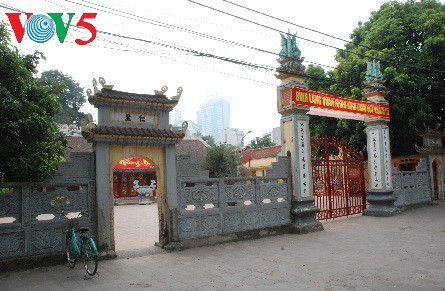 Quan Nhan village's communal house. Quan Nhan village's communal house. |
Along the To Lich river, Ke Moc encompasses the five villages of Giap Nhat, Quan Nhan, Chinh Kinh, Cu Loc and Phung Khoang, now part of Nhan Chinh and Trung Van wards in the Thanh Xuan and Nam Tu Liem districts of Hanoi. During the war, the Cu Loc communal house was destroyed and rebuilt in collaboration with Chinh Kinh as the Cu Chinh communal house.
The five Moc villages’ festival is an ancient festival held in rotation from the 10th to the 12th day of the second lunar month by the five villages to pay tribute to the villages’ tutelary gods. This year, Quan Nhan village hosted the festival after a three-year COVID hiatus.
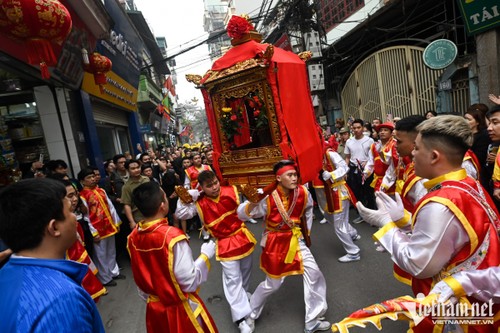 The procession of palanquins along the village road. The procession of palanquins along the village road. |
Mr. Nguyen Dinh Nang was born into the Nguyen An Son family, one of the biggest clans and greatest contributors to Quan Nhan village. Mr. Dang is now caretaker and deputy head of the management board of Quan Nhan’s communal house. He says there are many tales about the five Moc villages, but he told us the most popular version: “A long, long time ago during a difficult period, there were five hungry boys. A man gave them a sweet potato. The boys shared the sweet potato and then swore an oath to their brotherhood. The five Moc villages represent the five boys, and every five years, they hold a combined village festival.”
According to the inscription on a tablet enshrined at the sanctuary of the communal hall, Quan Nhan villagers worship a figure called Hung Lang Cong, who is said to be a descendant of the Hung Kings. They also venerate the hero’s wife as a goddess. Mr. Nang said: “According to historical records, Hung Lang Cong led the villagers and his troops to fight against Nam Chieu invaders from the North. In a sudden battle when his troops were ambushed, he fought to his last breath and heroically died. On hearing of her husband’s death, the wife killed herself to show her faithfulness and virtue.”
Impressed by his heroic death and wishing to continue to live under his protection, Quan Nhan villagers named him the village’s guardian deity and began worshipping at the village’s communal house.
It is a very common practice for villages in northern Vietnam to worship their guardian deity at the communal house, but only Quan Nhan village worships both a guardian deity and a goddess. At their village festival, people carry palanquins for the guardian deity and goddess to show their respect.
Though the festival begins on the 10th day of the second lunar month, villagers begin preparing for the festival a month earlier. First, Mr. and Mrs. Khoi Chi, who will lead the procession of palanquins, are selected. Mr. Nang elaborated: “Mr. and Mrs. Khoi Chi are selected based on several criteria. They must be local residents in good health. They must have a happy family and good financial health because they have to pay some of the expenses of the festival. After Mr. and Mrs. Khoi Chi are chosen, they take over the duties of the festival’s organizing board.”
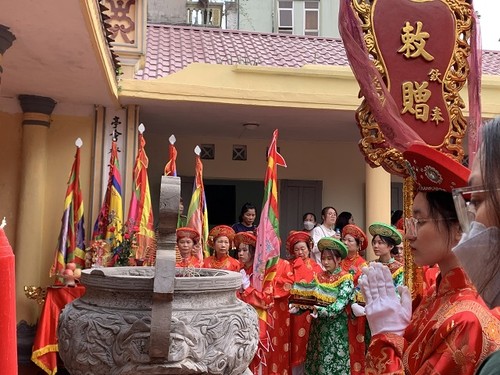 The goddess is worshipped at the temple (Photo: VOV5) The goddess is worshipped at the temple (Photo: VOV5) |
The festival requires a number of boys and girls to participate in the rituals. The boys and the girls must be unmarried, well-behaved, and come from good families. The number varies. The boys and girls chosen are responsible for carrying the palanquins, ritual objects, and flags during the procession. The costumes they wear depend on their assigned task. The boys who carry the palanquins wear sleeveless red jackets decorated with yellow fringes, yellow belts, black turbans, white shirts, and white trousers. The girls wear red robes with yellow-green tassels falling from the waist, black pants, and black turbans. If they carry ritual objects or flags, boys wear blue robes and blue turbans while the girls wear light pink robes with pink turbans, white pants, and white shoes.
A dragon dance team is indispensable at every festival to lead the procession and stir up the crowd. This year was the second time Mai Ngoc Tho has attended the festival. This time, he led the dragon dance troupe. Tho said: “Dragons and unicorns are considered sacred animals and have a great significance in the spiritual life of Vietnamese people. A dragon dance is an important part of the festival. Quan Nhan village’s dragon troupe has 25 members. For performances, we wear costumes of red and yellow, which represents the national flag of Vietnam and the heroic victory of our guardian deity.”
Before the festival, palanquins and statues are assembled in the yard of the communal house and decorated. Mr. Nguyen Uyen, deputy head of the festival’s organizing board, said: “The guardian deity is worshipped at the village’s communal house, while his wife is worshipped at the temple. There are eight-man palanquins, four-man dragon palanquins, and flower palanquins. Two eight-man palanquins carry the guardian deity and the goddess. During the procession, four-man dragon palanquins go first to protect the eight-man palanquins. The guardian deity and his wife are carried to Hoi Xuan temple, and after the festival, they are returned to the worshipping places.”
The festival begins with a rite called “Opening the communal house,” with the clans of all the villages gathered in the host village’s communal house yard.
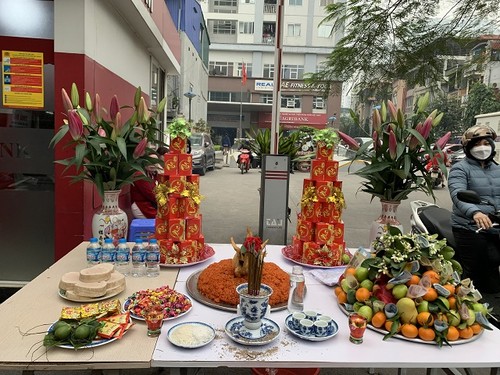 Villagers display offerings to welcome the palanquins of the guardian deity and the goddess (Photo: VOV5) Villagers display offerings to welcome the palanquins of the guardian deity and the goddess (Photo: VOV5) |
In the early morning, locals rush to the village roads, displaying offerings of fruits, sticky rice, and confectionaries, and line the roads to welcome the palanquins of the guardian deity and the goddess. Ms. Hoang Thi Thuy is a Quan Nhan villager: “Waiting for the palanquins to pass by is so exciting. The festival is so colorful, with the procession of palanquins coming from different villages. We prepare a feast to welcome the tutelary gods.”
At 5:30 a.m a procession departs from Phung Khoang village, passes along Nguyen Trai road, and makes its way to Quan Nhan village. Other processions come from other Moc villages to Quan Nhan, the festival’s host. Along the route, the procession is welcomed and joined by residents of the villages and visitors, who form a large crowd behind the procession, led by a dragon dance troupe, followed by Buddhist representatives carrying flags and fans, and groups of boys playing drums and girls dancing. Each palanquin is carried by eight boys wearing red garments and black turbans. Another group carrying flags and worshipping objects follows.
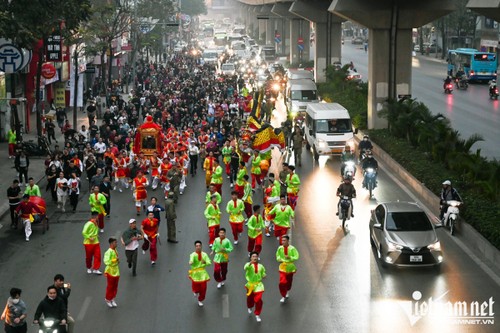 The procession passes along Nguyen Trai road. The procession passes along Nguyen Trai road. |
The highlight of the procession is the “revolving palanquins”. According to legend, when the saints meet, they make the palanquins revolve. The boys carrying the palanquins move around quickly, lowering and rotating the palanquins as the crowds cheer loudly.
The processions go from one village to another, eventually arriving at Quan Nhan village. Each village must wait 20 years for its turn to host the festival. Mai Ngoc Tho is excited to be attending the Five Moc Villagers’ Festival for the second time. Tho said: “20 years ago I was a boy following the drum group in Quan Nhan village’s festival, now I am the head of the lion dance group. I have seen great changes in my village during that time. I still remember the vibrant atmosphere of my village festival in the past. The statues of horses and elephants and the palanquins were lined up along the village road. Every child, like me, was very excited. When we stepped out of the house, we immediately felt the festive atmosphere. Now, with an increasing number of vehicles on the roads, the festival’s rituals are held very early in the morning at the communal house.”
Recreational activities are part of the festival, including music performances, poetry recitals, and folk games such as human chess. Ms. Nguyen Thi Van Tu is from the art and poetry group of Quan Nhan village. She said: “I bring to the festival four music performances, including ceremonial singing and songs in praise of the homeland and the village festival. We look forward to this festival.”
After the procession, representatives from each village gather in the yard of the Quan Nhan communal house and perform rituals to express gratitude to the tutelary gods. Mr. Nang again: “The festival is important to the villagers. It is a time to get together and encourages the younger generation to be more responsible and continue the village traditions.”